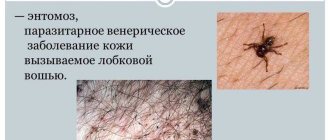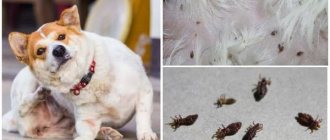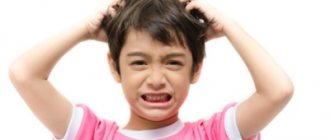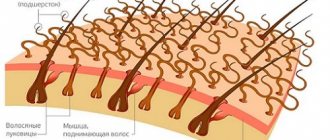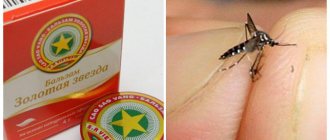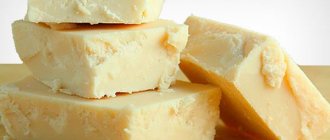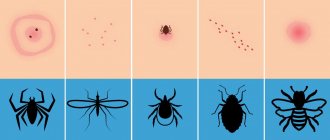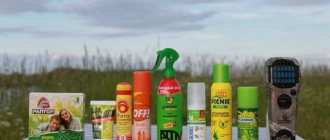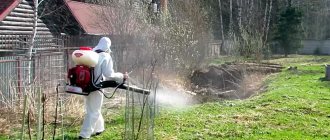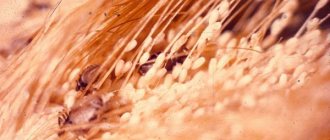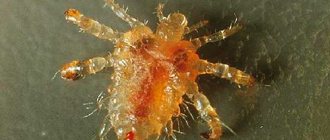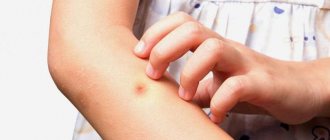Lice are small parasitic insects on the human body. Their habitat is bed linen, clothing and human hair. The medical name of the disease is pediculosis (lice).
What does a human louse and nit look like (on the head):
What to do in such a situation? To get started, we recommend reading this article. This article describes in detail methods of controlling parasites. We also recommend that you consult a specialist. Read the article >>>
- The length of an adult head louse is 2-4 mm, and that of a larva is from 0.7 to 2 mm.
- They are light yellow or brown in color, which helps them hide in the hair and scalp.
- Lice are usually found on the scalp, but can be on the eyelashes and eyebrows.
- They feed exclusively on blood.
- After being saturated with blood, the abdomen turns red, which makes the louse more noticeable.
Life cycle
In its development, the head louse goes through several stages:
- Females lay white eggs - nits. They attach very well to the hair right at the very roots. Sometimes you can see dead nits that are brown in color or empty ones that are light in color and look like dandruff.
- Nits grow from 7 to 9 days. Then it develops - a nymph, the so-called cub.
- After 10-12 days, the nymph turns into a mature louse, which is ready to reproduce and give birth. The louse lives for 28-30 days, and during this time they lay 200-300 eggs.
Development period
A nit is the initial stage of louse development. The louse develops from egg to adult within 2-4 weeks. During this time the following periods are observed:
- egg (nit);
- larval stage;
- 1st and 2nd order nymphs;
- adult parasite.
After a week or a little longer, the nit becomes a larva. The ripening period depends on temperature conditions. So, the most favorable temperature is the human body, that is, 36.6 degrees with minor fluctuations. But if you don’t wear a hat in the cold or the heat is unbearable in the summer, then the life cycle of lice slows down, but does not stop.
Once the louse has emerged from the outer shell of the cocoon, it begins to feed. And literally after 2 days the female is ready to reproduce. During her life, the female lays many eggs - 80-150 nits. In favorable conditions (air temperature +30), the number of lice increases tens of times in just a few months.
Reproduction
Lice reproduce by laying eggs on the scalp. A sticky secretion that hardens well in air, promotes good attachment to the hair and further helps to better preserve the future generation. Such increasing offspring require large amounts of energy from adults, so they feed a lot, 3 to 10 times a day.
Lice have a strong and multi-layered shell. It helps protect against high temperatures and certain chemicals.
The incubation period of nits found on hair is from 5 to 9 days. Insect reproduction depends on external influences. The more a person is in a cold room, the longer the parasite grows.
The ideal temperature for lice breeding is 24-30 °C. If it drops below 20, the reproduction process slows down or stops altogether.
The transition to adulthood occurs in 19-23 days. During this time, the larva goes through all stages and becomes capable of reproduction. Parasite reproduction proceeds very quickly. Females mate with males immediately after emerging from the nymph stage. One mating is enough to fertilize all the eggs. Then she lays 2-4 eggs a day. Over the course of her life, one female lays about 140 nits.
Ways of infection with pediculosis
Anyone can get head lice, regardless of gender, age, race or nationality. The social status of the infected person does not matter. But it is still possible to identify a certain group of people who are most likely to get the disease.
Risk group:
- people in prison;
- people without a fixed place of residence;
- people leading a wandering lifestyle;
- refugees;
- residents of zones of armed conflict;
- military personnel who have been in barracks and training grounds for a long time;
- tourists staying in hotels with a dubious reputation;
- hairdressers;
- children (usually girls) attending children's educational institutions, sanatoriums and camps.
There are two ways to get head lice:
- Contact with a person already suffering from head lice. In the case of head lice, contact means being close to the hair of an infested person. For example, during a hug, during close touching on public transport or a group selfie. A normal handshake does not transmit head lice, but body lice can.
- Contact with this person's belongings. If you combed your hair with a patient's comb or brush, slept on his pillow or bed, put on his hat, etc., infection will most likely occur.
However, if you are in the same room with a carrier of head lice for several hours, the likelihood of infection increases the more the longer the communication continues. That is why children attending kindergarten or school often suffer from pediculosis. Kids are careless and careless, they often hug, exchange toys and accidentally get infected. Teenagers, who often spend the night at each other’s houses, exchange clothes and hats, share hairpins and elastic bands, and kiss, are no more cautious.
What do nits look like?
Female lice are quite fertile and are able to lay eggs several times during the day. A nit is a capsule that is covered with an adhesive membrane. It is thanks to the adhesive substance that the egg is attached to the hair. When examined under a microscope, a tail is identified, which fixes the parasite on the hair.
Live and dry nits differ in their appearance. Living eggs are white and glisten when illuminated. After the louse hatches from it, the white shell gradually darkens to a gray-yellow hue, but remains on the hair. This visually leads to the fact that the number of nits significantly exceeds the number of lice.
Types of lice depending on color
Parasites of the following colors are found:
- Brown;
- Red;
- Grey;
- Black.
Brown
Most lice are different shades of brown. Sometimes there are even insects of yellowish tints, such as sheep linognath. Most parasites that live on animals have this exact color.
Red
Only one type of lice has this color - porcine hematopin . Most of the parasite's body is colored from red to dark pink. There are dark spots on the sides of the body.
Also, the body of a parasite feeding on blood can acquire a red tint immediately after it has bitten its victim.
Grey
Head lice and body lice have this color . The first variety has a darker shade.
Black
Sometimes among the head parasites there are black individuals. This color of chitin is due to the temperature at which insect eggs developed. If a person caught lice during a very cold or, conversely, very warm period of time, then each new generation will have a darker color. Temperature changes cause the insect's body to secrete more pigment. Although. In fact, the louse remains gray, but the increased amount of pigment causes our eyes to see a black insect in front of us.
Where do nits come from?
Most often, lice are transmitted through close contact, during which the louse moves on to the next victim. The nit cannot move on its own, so this type of infection is less common. This can happen if you share a comb, a hat, a bobby pin, or a hair tie.
Under the age of 12, children are constantly in contact with peers, so the prevalence of head lice in children and adolescents is high. And if a disease is detected in one of the students, it is recommended that all his classmates, as well as their families, undergo treatment.
Causes
To avoid getting sick, you need to know where lice come from. The source of transmission is a person who has parasites on the body or in the hair.
Photos of children's hair are a clear opportunity to diagnose the disease.
You can become infected with them in the following ways:
- With skin-to-skin contact. This could be hugging or sexual contact.
- Through personal items. Usually these are combs, elastic bands, scarves, pillows, towels. You can get pubic lice through underwear, and head lice from someone else's hat.
- Of water. Lice live in pools, seas and lakes for about two days. They can also crawl out of sand, including from a sandbox.
Provoking factors for head lice include:
- long hair;
- unsanitary living conditions;
- ignoring the rules of personal hygiene;
- low parental control over the child.
Most often, outbreaks of the disease appear in places where homeless people live, prisons, shelters, and also where there is no free access to water and conditions that do not meet sanitary standards are observed. By knowing how lice are transmitted, you can protect yourself and your child.
What threat do they pose?
The immature nits themselves do not pose a threat, with the exception of the unattractive appearance of the hair and white formations in it. But when the louse begins its parasitic life, symptoms appear that can significantly worsen the quality of everyday life. These symptoms include:
- almost constant itching of the scalp;
- infection of scratches and wounds, their infection and suppuration;
- sleep disturbance;
- inability to concentrate;
- irritability, nervousness.
Sometimes typhus or age-related typhus can become a complication of pediculosis. Infection of damaged skin after a louse bite, which is dangerous to health, occurs as a result of contact with the waste products of parasites, that is, with liquids and feces. The main unpleasant consequence of infestation with lice and nits is constant discomfort and apparently dirty hair.
Types of lice - depending on appearance
The body of parasites has a flattened shape. The legs are relatively short, but very tenacious, allowing the insects to hold tightly to a person or animal. Usually they have three pairs.
The body of lice, like other insects, consists of three parts: head, chest and abdomen. The head has an angular-oval shape, narrowed at the front, on which there is a pair of short antennae and a pair of simple eyes. The mouth opening is located on the front of the head.
The parasites' chest has a trapezoidal shape and consists of 3 closely connected segments, each of which has a pair of legs attached. At the end of each paw there is a well-developed movable claw, forming something like a claw.
In general, all types of lice have the same structure. Therefore, they can be divided only by the shape of the chest and abdomen:
- Oval (or ovoid) shape . Like head or body parasites;
- Diamond Shape. For example, pubic lice have this form.
Lice have completely absent wings . These parasites once had wings, but during the course of evolution and the acquisition of a parasitic lifestyle, they lost them as unnecessary. If you encounter an insect with wings, know that it is definitely not a louse.
How they appear on a person’s head
The most common way head lice occurs is through close contact with an infected person , as well as wearing hats of such a person or using his comb.
Close contact for the appearance of lice and nits is those actions of an infected and healthy person in which their heads touch. For example, children often play together, after which lice immediately spread throughout the entire group of children.
Nits cannot appear out of nowhere, as they are a consequence of lice infestation, which can only be transmitted from another person.
Also, even if one capsule gets on the head, which happens very rarely, the disease will not be able to develop, since there will simply be no conditions for reproduction.
Capsules appear on the hairline almost immediately after several lice get on it, as the process of reproduction begins.
Head louse under magnification
Linen lice
People need to know what linen lice look like in order to be able to distinguish them from head lice. Outwardly, they are slightly larger, settle on clothing, closer to the human body, affecting the back, sides, and limbs. Linen lice bites are always located on the body. Over their long history of existence, parasites have developed the necessary adaptations in the structure of their bodies that allow them to live on tissue, so such parasites will not be able to move to the head.
Symptoms
How can you tell if there are nits? Symptoms of the disease, as a rule, are invisible immediately after its appearance, since they are not very pronounced and a person simply does not consider it necessary to pay attention to them. Despite this, it is possible to detect signs of head lice in the first days of infection.
The following symptoms of infection exist:
- Constant itching that does not go away even with strong scratching of the skin.
- The presence of bites, since the entire diet consists of human blood. To prevent the bites from healing, the parasites inject a special secretion that interferes with the blood clotting process.
- Slight tingling, like a mosquito bite. The sensations of a mosquito bite and a louse bite are the same.
- The presence of white bodies in the root part of the hair.
Of the above symptoms, the most noticeable is itching. Most often, it is this that becomes the reason for contacting a medical specialist or conducting a thorough examination of the head at home.
Are there nits without lice?
Such a case is possible, but very rare. The discovery of empty nit capsules, where there are no longer living individuals, makes you think carefully about the situation. The answer to many questions is that measures to combat head lice were applied either on purpose or by luck.
There are no living specimens on the head, as they died as a result of some impact. One of the types of such effects is painting with a mixture containing hydrogen peroxide, or bleaching hair, as a result of which the peroxide destroys lice and nits.
What do they eat?
Lice feed exclusively on blood (mainly human), their oral apparatus is adapted specifically to pierce the skin and pump out blood. Other power sources are not available to them. They cannot feed on hair, skin or dandruff as some people believe.
Lice feed about 5 times a day every 2-3 hours. In one suction, a louse can drink approximately 0.5 mg of human blood. Saturation with blood allows parasites to reproduce and lead an active life.
Treatment methods
There are several ways to rid the skin of nits, lice, and, accordingly, the symptoms accompanying the disease, the most unpleasant of which is the constant persistent desire to scratch your head.
- The mechanical method is combing with a specialized comb with a tooth frequency of 0.2–0.3 mm. This method is the safest. This comb can be purchased at any pharmacy.
- Using shampoo will have a fairly strong effect, removing a significant part of the parasites, and will be an excellent preparation for subsequent combing.
- After combing and washing the head with a special shampoo , some of the nits may remain on the hair. In this case, the removal process can be continued using chemical medications. If you decide to use only pharmaceutical medications, relief can occur within a few uses. They will help get rid of head lice at home.
You should not abuse chemicals, as they can cause significant harm not only to parasites, but also to human hair and skin.
Effective methods of disposal
You can get rid of these parasites forever both in special institutions and at home. But considering how many products are available in the pharmacy, you can do it at home.
There are several ways to get rid of this disease.
Shaving the hair from your head is a very easy and effective approach. Fast and safe method. However, it will not suit those who are embarrassed to go out with a shaved head, especially girls who feel sorry for their hair. A good way to get rid of lice in young children.
Special products for removing lice - shampoos, sprays, lotions and creams. A definite plus is hair preservation. Disadvantages - there may be an allergic reaction and itching to some components of the drugs. The principle of use is simple: the product is applied in 2 stages and left on the hair for 3 hours. The second treatment is carried out after 5-7 days.
Combing out lice. You will need a special comb with very fine teeth. Allows you to separate stuck nits from hair and comb out adult nits. A safe, but very time-consuming method that requires extreme care. Typically, the comb is used in conjunction with shampoo or lotion to improve performance.
Folk remedies - oil, kerosene or vinegar. The main thing is to be vigilant and follow safety rules.
- Dilute 9% vinegar (table, apple or wine) with water in a ratio of 1:2. Moisten dry hair with the resulting vinegar solution and put on a plastic cap. Leave for 30-60 minutes, comb out parasites with a comb and rinse hair with water. There is no need to increase the concentration of vinegar, as this can lead to scalp burns.
- Oil hair mask. Mix a glass of any oil with a glass of 9% vinegar. Apply the mixture to dry hair along the entire length and leave for 7-8 hours. Comb out nits and adults, wash your hair with shampoo.
- kerosene with oil and shampoo in a ratio of 2:2:1, apply to dry hair and leave for 1 hour for children and 2 hours for adults. Afterwards, wash your hair with shampoo and rinse with water and vinegar.
Drugs. An effective and high-quality method. Some medications for children and adults are listed below. They are safe and will not harm the child or your health. Important! Follow the rules specified in the instructions!
Nyuda is a spray containing the excellent product dimethicone. It is part of the chemical composition of liquid silicone. As a result, it does not poison the lice, but clogs their airways. To remove nits from hair, the kit comes with a special comb.
Medifox is a very powerful remedy. This drug should not be used on children.
Pediculen Ultra is a very affordable medicine from a domestic manufacturer. It is not only able to eliminate lice, but also destroys nits.
Pair Plus - includes 3 powerful insecticides at once and can cure lice in 1 dose.
Elimination of lice and their larvae using a special drug or poisonous folk medicine is usually carried out according to the following points:
- The medicine is applied to the hair in the quantities specified in the instructions itself. Shampoos for wet hair, creams for damp hair and sprays for dry hair.
- Then use a cap (plastic bag) to hold it for the required time.
- Then we wash the medicine off the head and wash the hair with regular shampoo.
- After the procedures, comb out lice and nits with a comb.
https://www.youtube.com/watch?v=mGS4AuTy9Tc&feature=youtu.be
